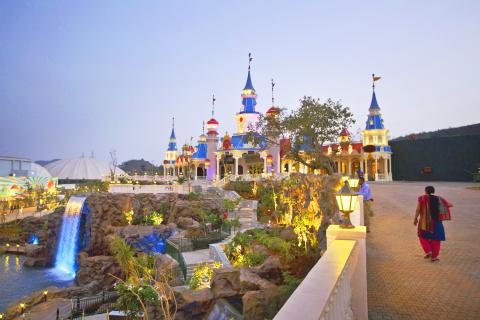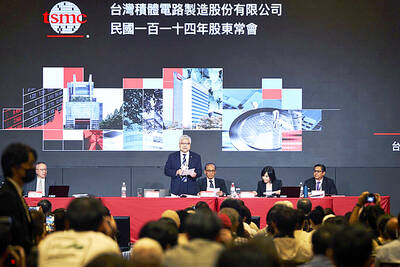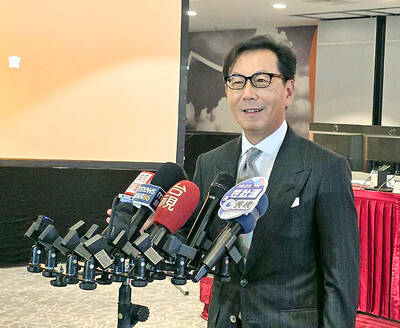India’s most elaborate theme park opened this week with special-effects Hindu gods and Bollywood-themed rides, aiming to tap a thirst for family entertainment among the country’s rising middle-class.
Adlabs Imagica, which cost about US$294 million to create, opened its doors to the public on Thursday between the western cities of Mumbai and Pune, with capacity for 10,000 to 15,000 visitors a day.
In the style of a Disney or Universal Studios park, the new tourist site hopes to fill a gap in the Indian leisure market and comes with twists to appeal to the domestic audience.

Photo: Bloomberg
Attractions include a “Wrath of the Gods” show, in which Hindu deities furious with humans “cause the ultimate destruction” amid temple ruins.
The “Curse of Salimgarh” involves a haunted fortress named after an old Delhi structure, while a “Mr India” motion-simulation ride is based on a 1987 Hindi superhero film of the same name.
“It was our vision to create an entertainment theme park of international standards in India,” said Manmohan Shetty, whose firm Adlabs Entertainment Ltd set up the complex.
A water park, hotel and shopping area will also be launched at the 121-hectare site in phases, while Shetty plans to open another venture in the southern Indian city of Hyderabad in 2015.
Tickets are expensive by Indian standards — at 1,200 rupees (US$22) for children and 1,500 rupees for adults on weekends — but Shetty is confident of meeting a target of 3 million visitors a year.
A day out for a family of four could cost about 10,000 rupees — “not a huge expense once or twice a year,” said the Bollywood entrepreneur, who also introduced multiplex cinemas to India.
The park will attract urban middle-class families who are spending in ways unimaginable a decade ago, but who still have limited leisure options, said Ankur Bisen, vice president at consultancy Technopak Advisors.
Since India’s economy was liberalized in the early 1990s, household spending has risen on new areas such as eating out and travel, spurred by increased exposure to global trends, Bisen said.
“It’s affordability meets desirability,” the retail and consumer products analyst said. “People are starting to see what they’re missing in their lives.”
The new park fits the trend across Asia, which has become a new frontier for large-scale outdoor entertainment complexes in recent years thanks to growing affluence and cheaper air travel.
Disney is constructing a US$5 billion theme park resort in Shanghai, while Asia’s first Legoland opened to packed crowds in Malaysia late last year.
Such attractions on the continent draw more than 100 million visitors and up to US$3 billion in revenues a year, said Chris Yoshii, Hong Kong-based director in Asian leisure and cultural services at consultancy AECOM.
“It’s really been in the last 10 years there’s been very strong growth of 5 to 10 percent per year,” he said.
However, India is yet to attract major global theme park operators to its shores, in part because of concerns over infrastructure and spending power.
On a recent visit to Mumbai, Walt Disney International boss Andy Bird was reported as saying the firm had no plans to open a park in the country, instead focusing on its Shanghai resort.
Adlabs imported all of its new rides owing to India’s lack of technology and it took on staff with experience at international theme parks — but it could be some time before the big names arrive themselves.
“We’re at the point where the market is not big enough for Disney to come in, but it’s big enough for an Indian businessman to come and seize the opportunity,” Bisen said.

CAUTIOUS RECOVERY: While the manufacturing sector returned to growth amid the US-China trade truce, firms remain wary as uncertainty clouds the outlook, the CIER said The local manufacturing sector returned to expansion last month, as the official purchasing managers’ index (PMI) rose 2.1 points to 51.0, driven by a temporary easing in US-China trade tensions, the Chung-Hua Institution for Economic Research (CIER, 中華經濟研究院) said yesterday. The PMI gauges the health of the manufacturing industry, with readings above 50 indicating expansion and those below 50 signaling contraction. “Firms are not as pessimistic as they were in April, but they remain far from optimistic,” CIER president Lien Hsien-ming (連賢明) said at a news conference. The full impact of US tariff decisions is unlikely to become clear until later this month

GROWING CONCERN: Some senior Trump administration officials opposed the UAE expansion over fears that another TSMC project could jeopardize its US investment Taiwan Semiconductor Manufacturing Co (TSMC, 台積電) is evaluating building an advanced production facility in the United Arab Emirates (UAE) and has discussed the possibility with officials in US President Donald Trump’s administration, people familiar with the matter said, in a potentially major bet on the Middle East that would only come to fruition with Washington’s approval. The company has had multiple meetings in the past few months with US Special Envoy to the Middle East Steve Witkoff and officials from MGX, an influential investment vehicle overseen by the UAE president’s brother, the people said. The conversations are a continuation of talks that

CHIP DUTIES: TSMC said it voiced its concerns to Washington about tariffs, telling the US commerce department that it wants ‘fair treatment’ to protect its competitiveness Taiwan Semiconductor Manufacturing Co (TSMC, 台積電) yesterday reiterated robust business prospects for this year as strong artificial intelligence (AI) chip demand from Nvidia Corp and other customers would absorb the impacts of US tariffs. “The impact of tariffs would be indirect, as the custom tax is the importers’ responsibility, not the exporters,” TSMC chairman and chief executive officer C.C. Wei (魏哲家) said at the chipmaker’s annual shareholders’ meeting in Hsinchu City. TSMC’s business could be affected if people become reluctant to buy electronics due to inflated prices, Wei said. In addition, the chipmaker has voiced its concern to the US Department of Commerce

STILL LOADED: Last year’s richest person, Quanta Computer Inc chairman Barry Lam, dropped to second place despite an 8 percent increase in his wealth to US$12.6 billion Staff writer, with CNA Daniel Tsai (蔡明忠) and Richard Tsai (蔡明興), the brothers who run Fubon Group (富邦集團), topped the Forbes list of Taiwan’s 50 richest people this year, released on Wednesday in New York. The magazine said that a stronger New Taiwan dollar pushed the combined wealth of Taiwan’s 50 richest people up 13 percent, from US$174 billion to US$197 billion, with 36 of the people on the list seeing their wealth increase. That came as Taiwan’s economy grew 4.6 percent last year, its fastest pace in three years, driven by the strong performance of the semiconductor industry, the magazine said. The Tsai